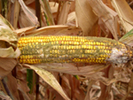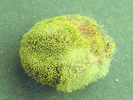David G. Schmale III
Virginia Polytechnic Institute and State University, Blacksburg, VA
Gary P. Munkvold
Iowa State University, Ames, IA
AFLATOXINS
 |
|
Figure 3 |
 |
|
Figure 4 |
Aflatoxins are one of the most potent and dangerous groups of mycotoxins worldwide. Over four billion people in developing countries are repeatedly exposed to aflatoxins, contributing to greater than 40 percent of the disease burden in these countries. Aflatoxins are produced primarily by the fungi Aspergillus flavus and Aspergillus parasiticus. There are four main types of aflatoxins: B1, B2, G1, and G2. Aflatoxin B1 is the major toxin produced, and is regulated in the United States at 20 ppb in agricultural products that may be used in human food. The clinical effects of aflatoxins may include death, liver cancer, reproductive problems, anemia, immune system suppression, and jaundice. Nursing animals may be severely affected by a toxic derivative of aflatoxin (aflatoxin M1) that can be passed through milk.
Aflatoxin contamination is economically important in crops such as maize, peanuts, cottonseed, and tree nuts. Aspergillus flavus is commonly associated with a disease of maize known as Aspergillus ear rot [Figure 3]. Powdery, grey-green spores may develop on the surface of maize ears, and aflatoxins may be produced by the fungus until the kernel moisture reaches about 15 percent. High temperatures, drought stress, and insect injury may contribute to increased aflatoxin contamination in maize. Aspergillus flavus and A. parasiticus may cause a disease of peanuts known as yellow mold [Figure 4], and high levels of aflatoxin contamination may result following relatively high temperatures and moderate humidity. Cottonseed, an important food source for dairy cattle, may become contaminated with aflatoxins if the seed-bearing capsules (bolls) are damaged, followed by high humidity and warm temperatures before or after harvest. Tree nuts such as pistachios and almonds may become contaminated with aflatoxins during injury, such as the splitting of hulls.
Next: Ergot alkaloids
